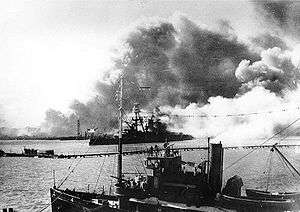USS Avocet (AVP-4)
USS Avocet (AM-19/AVP-4) was a Lapwing-class minesweeper initially acquired by the U.S. Navy for the dangerous task of removing mines from minefields laid in the water to prevent ships from passing.
 USS Avocet in foreground during the Attack on Pearl Harbor. USS Nevada is in the background, with a large American flag on her stern. | |
| History | |
|---|---|
| Builder: | Baltimore Drydock and Shipbuilding Co. |
| Cost: | $766,914 (hull and machinery)[1] |
| Laid down: | 13 September 1917 |
| Launched: | 9 March 1918 |
| Commissioned: |
|
| Decommissioned: | 10 December 1945 |
| Reclassified: | AM-19 to AVP-4 8 September 1925 |
| Stricken: | 3 January 1946 |
| Honours and awards: | Avocet (AVP-4) earned one World War II battle star for her participation in the defense of the fleet at Pearl Harbor on 7 December 1941 |
| Fate: | Sold to the Construction and Power Machine Co., Brooklyn, N.Y., on 12 December 1946 for use as a hulk. |
| General characteristics | |
| Class and type: | Lapwing-class minesweeper |
| Displacement: | 840 tons (853 tonnes) as AVP-4 |
| Length: | 187 ft 10 in (57.25 m) |
| Beam: | 35 ft 5 in (10.80 m) |
| Draught: | 15 ft (4.6 m) |
| Propulsion: | Triple Reciprocating engine |
| Speed: | 14 kn |
| Complement: | 75 |
| Armament: | 2 × 3"/50 caliber guns |
| Armor: | None |
Avocet was commissioned at the Norfolk Navy Yard, on 17 September 1918, as a minesweeper with Lieutenant Christian Crone in command.[2] Recommissioned on 8 September 1925 as a small seaplane tender, USS Avocet (AVP-4) was present during the Pearl Harbor attack on 7 December 1941. The ship survived the war, and was sold as a hulk on 6 December 1946.[2]
Avocet's role in the Attack on Pearl Harbor
At about 07:45 on Sunday, 7 December 1941, Avocet's security watch reported Japanese planes bombing the seaplane hangars at the south end of Ford Island and sounded general quarters. Her crew promptly brought up ammunition to her guns and the ship opened fire. The first shot from Avocet's starboard 3 in (76.2 mm) gun scored a direct hit on a Nakajima B5N2 ("Kate") carrier attack plane that had just scored a torpedo hit on the battleship USS California, moored nearby. The "Kate", from the aircraft carrier Kaga's air group, caught fire, slanted down from the sky, and crashed on the grounds of the naval hospital, one of five such planes lost by Kaga that morning.[2]
Initially firing at torpedo planes, Avocet's gunners shifted their fire to dive bombers attacking ships in the drydock area at the start of the forenoon watch. Then, sighting high altitude bombers overhead, they shifted their fire again. Soon afterwards five bombs splashed in a nearby berth, but none exploded.[2]
From her veritable ringside seat, Avocet then witnessed the sortie of the battleship USS Nevada, the only ship of her type to get underway during the attack. Seeing the dreadnought underway, after clearing her berth astern of the burning battleship USS Arizona, dive-bomber pilots from Kaga singled her out for destruction, 21 planes attacking her from all points of the compass. Avocet's captain, Lieutenant William C. Jonson, Jr., marveled at the Japanese precision, writing later that he had never seen "a more perfectly executed attack." Avocet's gunners added to the barrage to cover the battleship's passage down the harbor.[2]
Although the ship ceased fire at 10:00, much work remained in the wake of the devastating surprise attack. She had expended 144 rounds of 3 in (76.2 mm) and 1,750 of .30 in (7.62 mm) ammunition in the battle against the attacking planes, and had suffered only two casualties: a box of ammunition coming up from the magazines had fallen on the foot of one man, and a piece of flying shrapnel had wounded another. Also during the course of the action, a sailor from the small seaplane tender USS Swan, unable to return to his own ship, had reported on board for duty, and was immediately assigned a station on a .30 in (7.62 mm) machine gun.[2]
Oil from ruptured battleship fuel tanks had been set afire by fires on those ships, and the wind, from the northeast, was slowly pushing it toward Avocet's berth. Accordingly, the seaplane tender got underway at 10:45, and moored temporarily to the magazine island dock at 11:10, awaiting further orders which were not long in coming. At 11:15, she was ordered to help quell the fires still blazing on board California. She spent 20 minutes fighting fires on board the battleship with the submarine rescue ship USS Widgeon, and was then directed to proceed elsewhere.
Leaving California at 12:15, she reached the side of Nevada 25 minutes later, ordered to assist in beaching the battleship and fighting her fires. Mooring to Nevada's port bow at 12:40, Avocet went slowly ahead, pushing her aground at channel buoy no. 19, with fire hoses led out to her forward spaces and her signal bridge. For two hours, Avocet fought Nevada's fires, and succeeded in putting them out.[2]
References
- "Table 21 – Ships on Navy List June 30, 1919". Congressional Serial Set. U.S. Government Printing Office: 762. 1921.
- "Avocet I (Minesweeper No. 19)". Dictionary of American Naval Fighting Ships. Navy Department, Naval History and Heritage Command.
- This article incorporates text from the public domain Dictionary of American Naval Fighting Ships. The entry can be found here.